Michael Sheldon, “How Russia is placing troops and equipment near the Ukraine border,” Digital Forensic Research Lab (DFRLab), December 8, 2021, https://medium.com/dfrlab/how-russia-is-placing-troops-and-equipment-near-the-ukraine-border-f84e1f07ab59.
How Russia is placing troops and equipment near the Ukraine border
Open-source evidence throughout 2021 shows Russian military buildup along Ukraine’s eastern borders and in Crimea.
How Russia is placing troops and equipment near the Ukraine border
Share this story

BANNER: Screenshots of Buk-M3, 2S1, and other equipment from the 34th MRB moving to Kerch, Crimea, with the Russian word for “rushed” superimposed on them. (Source: TikTok)
Russia is amassing troops and equipment near the Ukraine border and in Crimea, sparking concerns that an invasion could take place in the coming months. Ukrainian Minister of Defense Alexey Reznikov said Russia will be equipped to launch a large-scale escalation against Ukraine by the end of January 2022. Satellite imagery and online videos documenting Russian troop movements, as well as Kremlin rhetoric, support this assertion.
Using open-source evidence, the DFRLab has been tracking the Russian military buildup in Crimea and near the Ukraine border since spring 2021, and documented a resurgence of Russian military activity again in the fall. By comparison to Russian troop movements in spring, the military activity in recent months is more covert, making it difficult to gauge the exact size of the deployments. The troop movements outlined in this article should thus be considered a snapshot of the broader trend, rather than a comprehensive overview.
Kremlin rhetoric over the past year has targeted Ukraine’s reluctance to implement the Minsk II agreements and what it describes as Western nations emboldening Ukraine to pursue a military resolution to the conflict in the Donbas region. The latter statement, although untrue, remains a common trope throughout Kremlin messaging. Through implementation of Minsk II, Russia had hoped to exert influence over Ukraine to make NATO membership impossible. This calculation, however, appears to have shifted, and Kremlin messaging now suggests that it is finding the trajectory of NATO-Ukraine military cooperation unacceptable.
A December 1 statement by Russian President Vladimir Putin on Russia’s “red lines” regarding Ukraine cited growing concern over NATO-Ukraine military engagement, and the potential for NATO weaponry to be stationed in Ukraine. It now appears that Russia is taking coercive measures to compel its adversaries to deliver assurances that none of its stated red lines will be crossed.

Тhe DFRLab previously covered the initial buildup of Russian forces in Crimea and near the Ukraine border in spring 2021. Elements from the 41st and 58th Combined Arms Armies (CAA) in Siberia and the North Caucasus, respectively, along with large amounts of Russian airborne troops, were deployed to training areas in Crimea and Voronezh oblast in southwest Russia. After US President Joe Biden proposed a summit with his Russian counterpart, the buildup reached its climax with massive military exercises, and most units were returned to their permanent bases. The 41st CAA assets, however, were to remain in Voronezh for the ZAPAD 2021 exercises in September.
Yelnya: approximately 170 km from the Ukraine border
Yelnya camp houses the largest congregation, by far, of Russian units connected to the current buildup, and has been the subject of extensive reporting in traditional media as well as open source accounts on Twitter.
Throughout October 2021, equipment from the 41st CAA could no longer be seen at the Pogonovo training grounds near Voronezh. Simultaneously, a large collection of 41st CAA equipment appeared in Yelnya, Smolensk Oblast, at the 144th Motor Rifle Division’s (MRD) garrison as documented by the Russian military monitor Conflict Intelligence Team.
Satellite imagery posted to Twitter on December 6 by Radio Free Europe journalist Mike Eckel showed 41st CAA assets at Yelnya had increased compared to imagery released on November 1 by New York Times journalist Christiaan Triebert.
In late November, the 55th Mountain Motor Rifle Brigade (MRB) of the 41st CAA was spotted moving equipment from Abakan, in central Russia, to Yelnya. The brigade is the latest unit from the 41st CAA to be spotted moving to the site of the 144th MRD garrison. Movements have slowed in the last week as it appears that many units have already relocated to be closer to the Ukraine border.
The train carried a large amount of Tigr-M armored vehicles as well as other equipment. In early December, another video surfaced showing at least seven Nona-SVK 120mm self-propelled mortars. The vehicles bore similar markings to those in previous videos of the 55th MRB moving to Yelnya and may have been from the same train.
Opuk, Crimea: approximately 350 km from mainland Ukraine
From late October through November, military equipment has been recorded entering and exiting the Crimean Peninsula. Equipment has congregated at the Opuk training grounds similarly to the spring buildup, albeit at a smaller scale thus far. Additionally, a camp established near Novoozerne in spring 2021 appears to have retained a large amount of 58th CAA artillery assets and seems to have grown slightly over the past month.
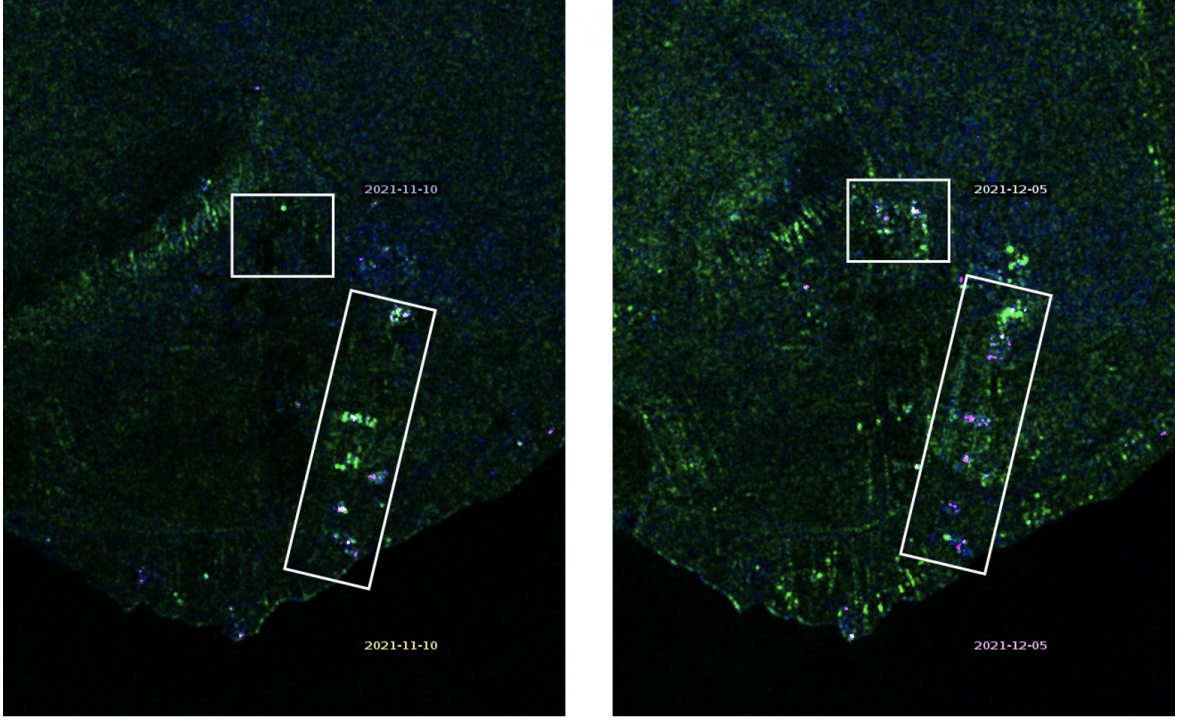
On November 12, a video appeared online showing a unit from the 34th MRB of the 49th CAA loading equipment onto a train destined for Kerch, Crimea. The equipment included a large amount of 2S1 122mm self-propelled artillery pieces, along with fuel and other support equipment.
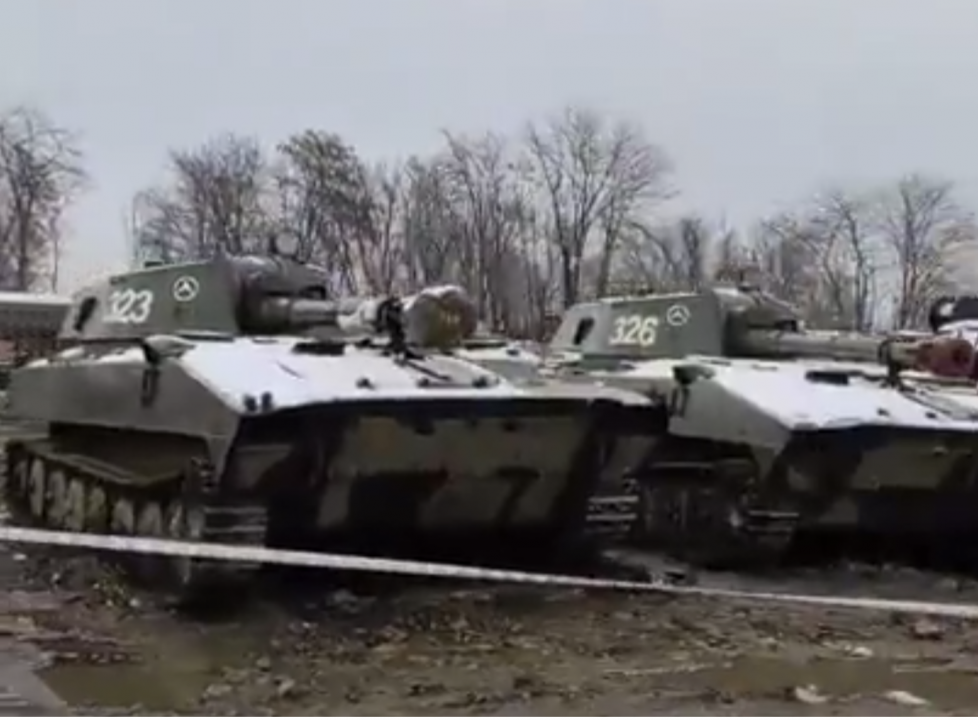
One day later, a train carrying 34th MRB equipment was spotted moving toward Kerch, loaded with 2S1 122mm artillery pieces and a Buk-M3 air defense system. It is unclear where this equipment went, but Opuk is a viable candidate. Later in the month, equipment from the 34th MRB was seen returning to its garrison, but whether this movement is connected to the above train sighting is unclear.

In mid-November, a train carrying a battalion’s worth of T-72 main battle tanks was spotted moving through Krasnodar, Russia, in broad daylight. The train, carrying tanks from the 42nd MRD of the 58th CAA, had left Russia’s Khankala station for Ayvazovskaya station in the Crimean Peninsula town of Feodosia.

Two weeks prior, a train full of T-72B1 tanks and BMP-2 infantry fighting vehicles was spotted heading towards Crimea. It was unclear what unit the equipment belonged to, or what station it was destined for, but the tanks garnered a large amount of media attention for their improvised defensive structures, allegedly able to shield troops from drone attacks.
On December 4, a video showed a train loaded with 2S9 Nona-S 120mm self-propelled mortars. The mortars were sent to Feodosia, Crimea, from Staromevsk station in Stavropol, Russia. The departure station, along with the equipment type, suggests they were sent by the 249th Air Assault Regiment, which is based in Stavropol.

Additionally, a video posted on November 26 shows a train loaded with a large amount of airborne equipment, including BMD-2, Nona-S, and more. According to rail data, the equipment was from the 31st Air Assault Brigade in western Russia’s Ulyanovsk and moved from the brigade’s garrison at Cherdakly station to Ayvazovskaya station in Feodosia, Crimea.

Maxar satellite imagery published by journalist Mike Eckel on December 6 showed a new camp at Novoozerne, on the northwestern portion of the Crimean Peninsula. The exact date of the imagery is unclear, but it was taken some time in the “past month,” according to Eckel, citing Maxar.
The camp contains a large amount of artillery assets from the 58th CAA which were not withdrawn from the initial buildup in spring 2021. The imagery revealed large quantities of tanks, MSTA-S 155mm self-propelled howitzers, towed artillery, and rocket artillery. Low-resolution synthetic-aperture radar imagery on Sentinel Hub suggests that more equipment may have arrived at the southern portion of the camp since the above image was taken.
Maslovska rail station: approximately 180 km from the border
In the months of October and November, footage from the Maslovka rail station north of the Pogonovo training grounds by Voronezh, in southwest Russia, revealed the arrival of large amounts of materiel belonging to the 4th Tank Division and 2nd MRD of the 1st Guards Tank Army, normally stationed near Moscow.
According to satellite imagery analysis by Konrad Muzyka of Rochan Consulting, the buildup of Russian military materiel at Pogonovo included two tank battalion tactical groups (BTG) TOS-1As, towed artillery, and rocket artillery as of November 27.
his analysis is backed up by rail traffic, which revealed where the military equipment came from, and a large amount of on-the-ground imagery. Due to the public nature of the Maslovka rail station, footage of Maslovka train station was posted on social media all throughout November.
One video taken at the Maslovka station and posted to TikTok on November 14, 2021, showed a battalion’s worth of T-80U tanks, a battalion’s worth of T-72s tanks, and four 2S19 MSTA-S self-propelled howitzers. At the time the video was posted, the equipment had been in Maslovka for several days, and many other videos had already been posted showing the equipment at the station.

On November 21, an image was posted of a TOS-1A thermobaric multiple rocket launcher parked at Maslovka station, along with a handful of MTLB armored vehicles. The launcher was part of a train previously spotted in a video uploaded on November 19 in which TOS-1As and other military vehicles were sent from the 20th Nuclear, Biological and Chemical Protection regiment. At least two TOS-1A launchers were visible in the video.
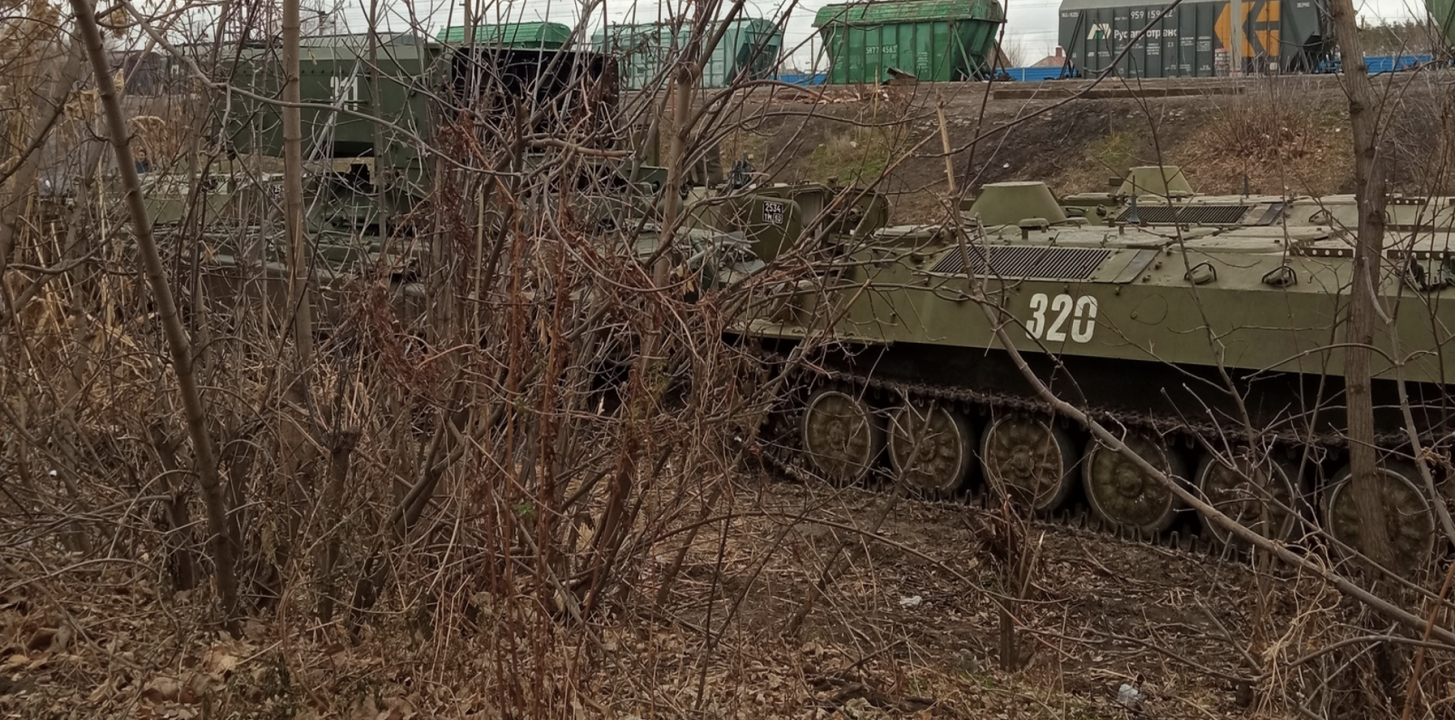
Earlier in the month, on November 9, at least seven BM-27 multiple rocket launchers were spotted moving north in Novaya Usman near Voronezh. It is unclear whether these are the multiple launch rocket system that appeared in satellite imagery of Pogonovo, but it is highly likely as BM-27s from the 41st CAA appear to had left by then.
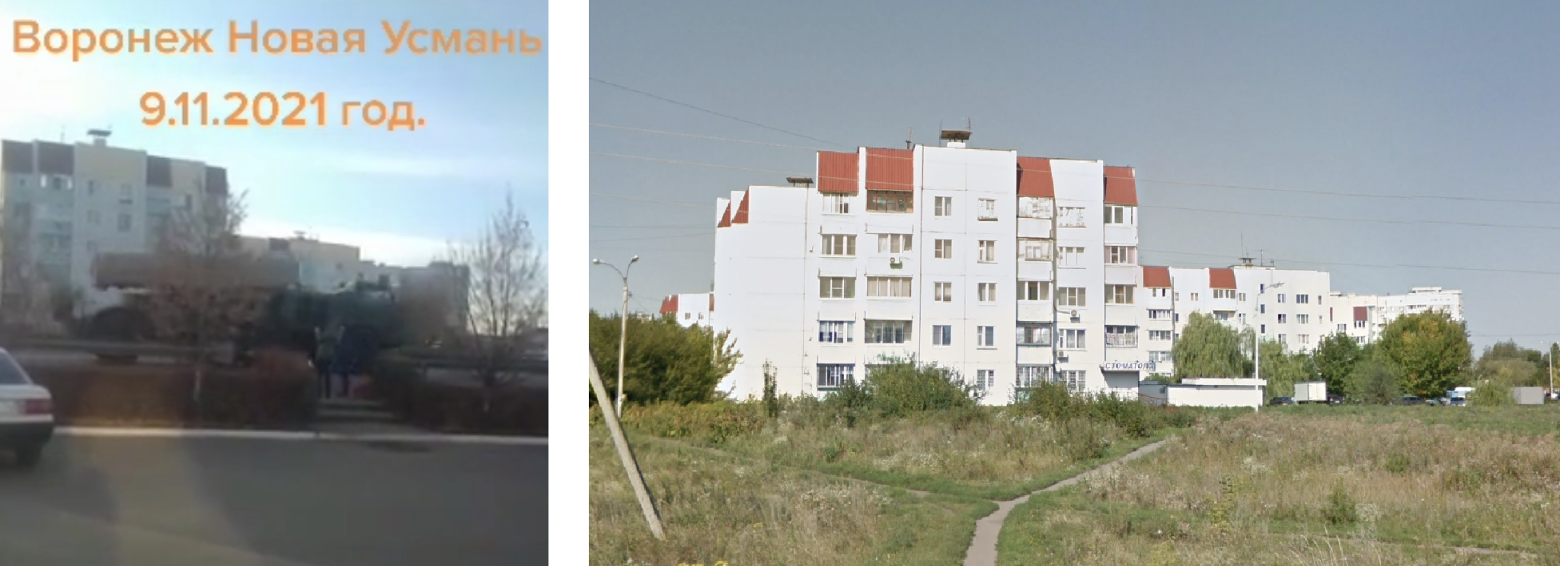
Valuyki/Soloti: approximately 15 km from the border
On November 19, a video appeared online showing a train full of BMD-3 infantry fighting vehicles. Rail data revealed that the vehicles were sent from the 22nd Central Tank Reserve Base in Buy to Valuyki, a town which lies approximately 15 kilometers from the Ukrainian border. Valuyki, along with the neighboring town Soloti, is also home to parts of the Russian Third MRD, which is headquartered in nearby Boguchar.
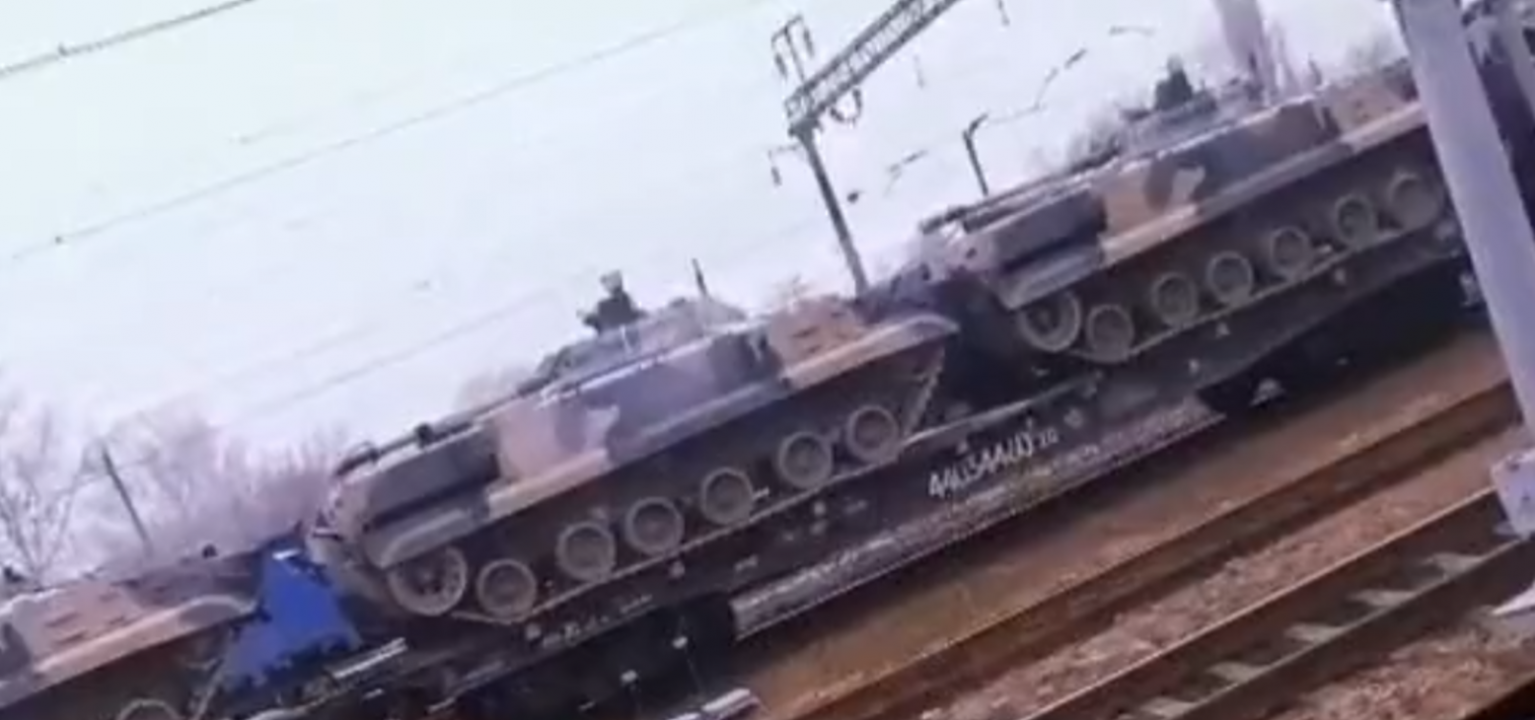
It is unclear whether these vehicles were intended to replace existing stock for units stationed at Valuyki, to fill inventory, or if they were intended to create new units. Satellite imagery from Planet Labs showed an increase in vehicle density at the Soloti garrison between October 29 and December 5, 2021. Compared to previous months, October 29th appeared to have a slightly higher number of vehicles in the southern portion of the base, but the increase was much starker on December 5.
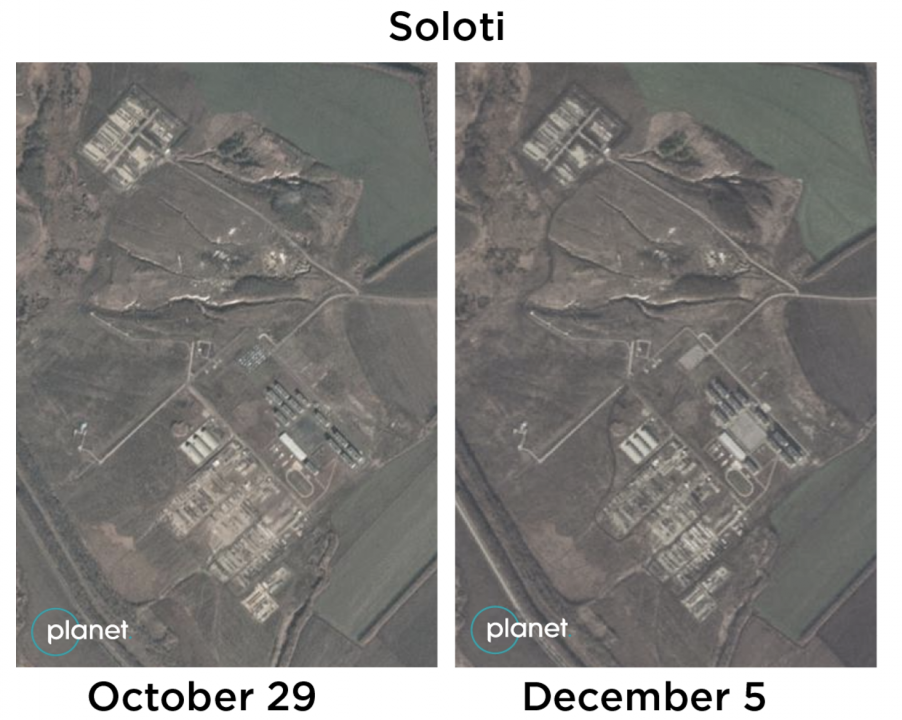
Other trains loaded with BMP-2s fighting vehicles were spotted on social media moving from their garrison in Klintsy to Valuyki in November but inexplicably appeared to return a few days later.
Conclusion
Over the past months, Russia has moved large amounts of equipment closer to the Ukrainian border from central Russia, Moscow, and the north Caucasus. Many units appear to have only partially moved to their forward bases but could quickly mobilize as the majority of these are located nearby in the North Caucasus or Moscow. Meanwhile, the 41st CAA has already moved vast amounts of equipment to Yelnya.
The open-source evidence largely complements maps like the one published in Military Times, showing a mobilization of the 4th Armored Division at Pogonovo, units from the 58th and 49th CAA moving into Crimea, and movement of the 2nd MRD within Russia. Viewed together, these movements signify Russian forces are amassing at several points near the Ukraine border, prompting fears of possible military action.


